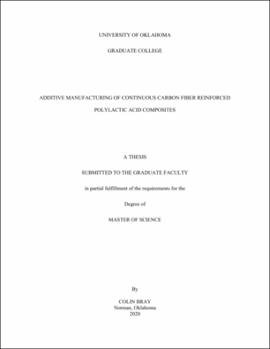| dc.contributor.advisor | Liu, Yingtao | |
| dc.contributor.author | Bray, Colin | |
| dc.date.accessioned | 2020-05-12T21:32:09Z | |
| dc.date.available | 2020-05-12T21:32:09Z | |
| dc.date.issued | 2020-05-08 | |
| dc.identifier.uri | https://hdl.handle.net/11244/324400 | |
| dc.description.abstract | Fused deposition modeling (FDM) is a category of additive manufacturing in which parts are fabricated via extrusion of material along a print path one layer at a time. A part is first created as a 3D computer-aided design (CAD) file before being converted to a standard tessellation language (STL) file, loaded into a slicer software such as Repetier-Host, and sliced. Slicing is the process of dividing the 3D digital model into layers for fabrication via additive manufacturing. G-code is generated as a result of this slicing process that dictates all necessary instructions to the printer for the fabrication of a part. In the case of this project, the g-code is then saved to a micro-USB drive before the drive is inserted into the printer.
Benefits of the fused deposition modeling process include great design freedom, cost-effectiveness, and versatility of materials and process. It is also well-known that adding reinforcement, such as continuous carbon fiber, to a thermoplastic matrix material can greatly increase material properties such as flexural strength. Thus, this thesis investigates the fabrication of continuous carbon fiber-reinforced polylactic acid (PLA) composites through in-nozzle impregnation. This involves feeding the fiber directly into the hot end of the printer prior to extrusion and extruding the continuous carbon fiber and PLA simultaneously through one nozzle. The continuous carbon fiber was coated prior to printing via a novel coating process that mitigated the issues of fiber fraying within the nozzle of the printer and tearing upon extrusion. Density and fiber volume fraction were measured in printed composites along with the completion of 3-point bending tests to measure flexural strength and elastic modulus. It was found that the addition of the continuous carbon fiber greatly increased both flexural strength and elastic modulus of printed samples when compared to samples printed of pure PLA. Furthermore, the effects of extrusion temperature and layer height on impregnation of the fiber with PLA were characterized, and it was determined that a minimal layer height is optimal for fiber impregnation. | en_US |
| dc.language | en_US | en_US |
| dc.subject | Additive Manufacturing | en_US |
| dc.subject | Composite Materials | en_US |
| dc.subject | Engineering, Mechanical. | en_US |
| dc.subject | Engineering, Materials Science. | en_US |
| dc.title | Additive Manufacturing of Continuous Carbon Fiber Reinforced Polylactic Acid Composites | en_US |
| dc.contributor.committeeMember | Saha, Mrinal | |
| dc.contributor.committeeMember | Altan, M. Cengiz | |
| dc.date.manuscript | 2020-05-08 | |
| dc.thesis.degree | Master of Science | en_US |
| ou.group | Gallogly College of Engineering::School of Aerospace and Mechanical Engineering | en_US |
| shareok.orcid | 0000-0003-4064-7231 | en_US |
| shareok.nativefileaccess | restricted | en_US |
